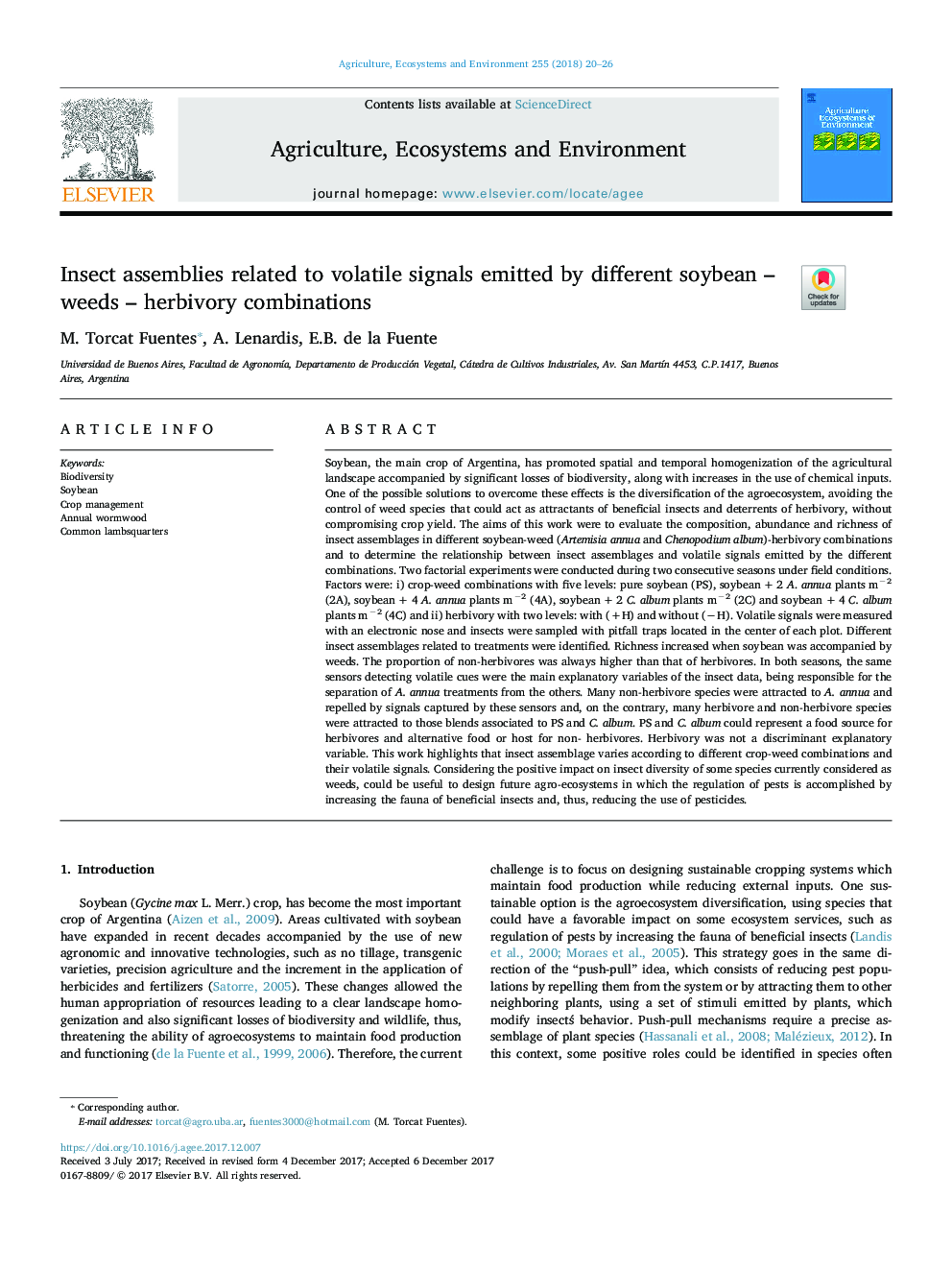| کد مقاله | کد نشریه | سال انتشار | مقاله انگلیسی | نسخه تمام متن |
|---|---|---|---|---|
| 8487182 | 1551997 | 2018 | 7 صفحه PDF | دانلود رایگان |
عنوان انگلیسی مقاله ISI
Insect assemblies related to volatile signals emitted by different soybean - weeds - herbivory combinations
ترجمه فارسی عنوان
مجموعه های حشرات مربوط به سیگنال های فرار منتشر شده از سویا های مختلف - علف های هرز - ترکیبات گیاهی
دانلود مقاله + سفارش ترجمه
دانلود مقاله ISI انگلیسی
رایگان برای ایرانیان
کلمات کلیدی
تنوع زیستی، سویا، مدیریت محصول، کرم چوب سالانه، مرغ مشترک،
موضوعات مرتبط
علوم زیستی و بیوفناوری
علوم کشاورزی و بیولوژیک
علوم زراعت و اصلاح نباتات
چکیده انگلیسی
Soybean, the main crop of Argentina, has promoted spatial and temporal homogenization of the agricultural landscape accompanied by significant losses of biodiversity, along with increases in the use of chemical inputs. One of the possible solutions to overcome these effects is the diversification of the agroecosystem, avoiding the control of weed species that could act as attractants of beneficial insects and deterrents of herbivory, without compromising crop yield. The aims of this work were to evaluate the composition, abundance and richness of insect assemblages in different soybean-weed (Artemisia annua and Chenopodium album)-herbivory combinations and to determine the relationship between insect assemblages and volatile signals emitted by the different combinations. Two factorial experiments were conducted during two consecutive seasons under field conditions. Factors were: i) crop-weed combinations with five levels: pure soybean (PS), soybeanâ¯+â¯2 A. annua plants mâ2 (2A), soybeanâ¯+â¯4 A. annua plants mâ2 (4A), soybeanâ¯+â¯2 C. album plants mâ2 (2C) and soybeanâ¯+â¯4 C. album plants mâ2 (4C) and ii) herbivory with two levels: with (+H) and without (âH). Volatile signals were measured with an electronic nose and insects were sampled with pitfall traps located in the center of each plot. Different insect assemblages related to treatments were identified. Richness increased when soybean was accompanied by weeds. The proportion of non-herbivores was always higher than that of herbivores. In both seasons, the same sensors detecting volatile cues were the main explanatory variables of the insect data, being responsible for the separation of A. annua treatments from the others. Many non-herbivore species were attracted to A. annua and repelled by signals captured by these sensors and, on the contrary, many herbivore and non-herbivore species were attracted to those blends associated to PS and C. album. PS and C. album could represent a food source for herbivores and alternative food or host for non- herbivores. Herbivory was not a discriminant explanatory variable. This work highlights that insect assemblage varies according to different crop-weed combinations and their volatile signals. Considering the positive impact on insect diversity of some species currently considered as weeds, could be useful to design future agro-ecosystems in which the regulation of pests is accomplished by increasing the fauna of beneficial insects and, thus, reducing the use of pesticides.
ناشر
Database: Elsevier - ScienceDirect (ساینس دایرکت)
Journal: Agriculture, Ecosystems & Environment - Volume 255, 1 March 2018, Pages 20-26
Journal: Agriculture, Ecosystems & Environment - Volume 255, 1 March 2018, Pages 20-26
نویسندگان
M. Torcat Fuentes, A. Lenardis, E.B. de la Fuente,
